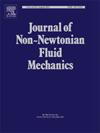Interplay between complex fluid rheology and wall compliance in the flow resistance of deformable axisymmetric configurations
IF 2.7
2区 工程技术
Q2 MECHANICS
引用次数: 0
Abstract
Viscous flows through configurations fabricated from soft materials exert stresses at the solid–liquid interface, leading to a coupling between the flow field and the elastic deformation. The resulting fluid–structure interaction affects the relationship between the pressure drop and the flow rate , or the corresponding flow resistance . While the flow resistance in deformable configurations has been extensively studied for Newtonian fluids, it remains largely unexplored for non-Newtonian fluids even at low Reynolds numbers. We analyze the steady low-Reynolds-number fluid–structure interaction between the flow of a non-Newtonian fluid and a deformable tube. We present a theoretical framework for calculating the leading-order effect of the complex fluid rheology and wall compliance on the flow resistance, which holds for a wide class of non-Newtonian constitutive models. For the weakly non-Newtonian limit, our theory provides the first-order non-Newtonian correction for the flow resistance solely using the known Newtonian solution for a deformable tube, bypassing the detailed calculations of the non-Newtonian fluid–structure-interaction problem. We illustrate our approach for a weakly viscoelastic Oldroyd-B fluid and a weakly shear-thinning Carreau fluid. In particular, we show analytically that both the viscoelasticity and shear thinning of the fluid and the compliance of the deformable tube decrease the flow resistance in the weakly non-Newtonian limit and identify the physical mechanisms governing this reduction.
可变形轴对称结构流动阻力中复杂流体流变与壁顺性的相互作用
由软质材料制成的结构的粘性流动在固液界面处施加应力,导致流场和弹性变形之间的耦合。由此产生的流固耦合作用影响了压降Δp与流速q或相应的流动阻力Δp/q之间的关系。虽然牛顿流体的可变形结构的流动阻力已经得到了广泛的研究,但即使在低雷诺数下,非牛顿流体的流动阻力仍未得到广泛的研究。本文分析了非牛顿流体与可变形管之间的定常低雷诺数流固相互作用。我们提出了一个计算复杂流体流变和壁顺性对流动阻力的阶效应的理论框架,该框架适用于广泛的非牛顿本构模型。对于弱非牛顿极限,我们的理论仅使用已知的可变形管的牛顿解提供了流动阻力的一阶非牛顿修正,绕过了非牛顿流体-结构-相互作用问题的详细计算。我们举例说明了我们的方法弱粘弹性的Oldroyd-B流体和弱剪切变薄的careau流体。特别是,我们分析表明,流体的粘弹性和剪切变薄以及可变形管的顺应性在弱非牛顿极限下降低了流动阻力,并确定了控制这种降低的物理机制。
本文章由计算机程序翻译,如有差异,请以英文原文为准。
求助全文
约1分钟内获得全文
求助全文
来源期刊
CiteScore
5.00
自引率
19.40%
发文量
109
审稿时长
61 days
期刊介绍:
The Journal of Non-Newtonian Fluid Mechanics publishes research on flowing soft matter systems. Submissions in all areas of flowing complex fluids are welcomed, including polymer melts and solutions, suspensions, colloids, surfactant solutions, biological fluids, gels, liquid crystals and granular materials. Flow problems relevant to microfluidics, lab-on-a-chip, nanofluidics, biological flows, geophysical flows, industrial processes and other applications are of interest.
Subjects considered suitable for the journal include the following (not necessarily in order of importance):
Theoretical, computational and experimental studies of naturally or technologically relevant flow problems where the non-Newtonian nature of the fluid is important in determining the character of the flow. We seek in particular studies that lend mechanistic insight into flow behavior in complex fluids or highlight flow phenomena unique to complex fluids. Examples include
Instabilities, unsteady and turbulent or chaotic flow characteristics in non-Newtonian fluids,
Multiphase flows involving complex fluids,
Problems involving transport phenomena such as heat and mass transfer and mixing, to the extent that the non-Newtonian flow behavior is central to the transport phenomena,
Novel flow situations that suggest the need for further theoretical study,
Practical situations of flow that are in need of systematic theoretical and experimental research. Such issues and developments commonly arise, for example, in the polymer processing, petroleum, pharmaceutical, biomedical and consumer product industries.

 求助内容:
求助内容: 应助结果提醒方式:
应助结果提醒方式:


